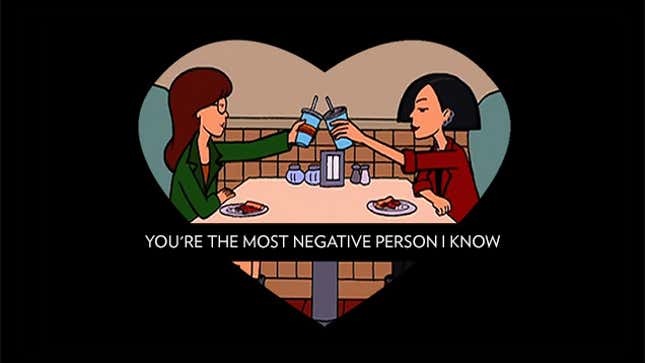The Misanthropic Love Story of Daria Morgendorffer and Jane Lane
Latest

There’s something fundamentally lonely about being a teenage girl: at least, the kind of teenage girl who is not only odd but who also knows it, who cultivates her oddness with jealous resolve while floundering under the burden of its social ramifications. This kind of girl both loves and loathes her loneliness; she would cringe at the idea of matching outfits, but secretly knows that shared sameness feels like home. If this girl came of age in the ’90s, she identified fiercely with Daria Morgendorffer and longed for a best friend like Jane Lane.
Daria originally ran on MTV from 1997 until 2001, cultivating an avid female fan base along the way. Pre-adolescents, twenty-somethings and those in the gulf between all sought relief in the take-no-shit, demure nihilism that distinguished Daria Morgendorffer and Jane Lane from the Joey Potters and Sabrina Spellmans of television.
Watching an episode of Daria folded us into the world Daria and Jane forged through their mutual cynicism. More than any other show of its generation, Daria understood the fierce attachment that comes from, at long last, discovering someone who finds most human beings as flagrantly buffoonish as you do. Here in this world, cheerleaders squeak like understudies for The Chipettes, emotionally mangled teachers wear their failures on their sleeves, and a crooked (and rather delusional) school principal scavenges for wealth and acclaim. Embracing social exclusion as a benediction, Daria and Jane’s twinned desire to reject social mores is the foundation of their relationship, the philosophy that makes their friendship almost a conviction.
Daria and Jane join misanthropic forces in the series pilot, when the two are (wonderfully) assigned to a course on self-esteem. Together, they plot a successful escape, and so begins the intimate and weird partnership of five seasons, which comes with a promise that it will continue beyond the series’ end: in the final movie-length episode, both girls are poised to attend college in Boston, and they toast pizza slices to a future of deadpan shit-talking.
Who could ever wish it otherwise? Daria and Jane are the acid-tongued power couple of our wildest dreams. They appreciate each other’s serrated contours (“You’re the most negative person I know,” Jane doesn’t not compliment). Daria’s chosen haven is Jane’s bedroom, where Jane wields her paintbrushes and pithy insights. Each girl loves her family in spite of herself, but a more satisfying iteration of home blossoms between them, over endless pizzas and walks home from school.-

-

-

-

-

-

-

-

-

-

-

-

-

-

-

-

-

-

-

-

-

-

-

-

-

-

-

-

-

-

-

-

-

-

-

-

-

-

-

-








































